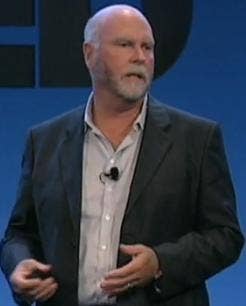Venter’s Successes in Creating Synthetic Life (video)

Share
Craig Venter is pushing the boundaries of what humans can do with DNA and aims to create new life to serve our needs. At TEDMED this past year, he discussed what he and his company, Synthetic Genomics, have accomplished by analyzing and manipulating the genes of simple organisms. While the presentation was titled "What could we do with synthetic life?" it would have been more apt to call it "What we have done so far is going to blow your freakin' mind." Venter gives an in depth look at the methods which will lead to custom made organisms. Biofuel, new antibiotics, vaccines - Venter could one day make them all by using yeast and bacteria to reproduce artificially constructed genomes. As many have said, synthetic biology is likely to be the defining technology of the 21st century, and Venter plans on helping to write that definition. Check out his TEDMED video, in its entirety, after the break.
Long time readers will know that I can never send you into a 18 minute video without a field guide. Here are some highlights so you can skip around as you see fit:
0:23 - Venter opens his talk by discussing how DNA is an analog software device, and details his gene mapping efforts to date.
2:45 - Unlike electronics, synthetic biology has more than 3 or 4 design components. There are 20+ million genes to use as basic parts.
3:15 - The simplest bacterium (genetically) has just 580 kb of data - about 500 genes. Venter wanted to find the most basic form of life you can make.
4:25 - If DNA = software, how do you boot it up? It took Venter more than a decade to artificially assemble the genome of a simple virus (5000 genes).
5:35 - But injecting bacteria with genes allows that DNA to be replicated very quickly. Software builds hardware in biology. At 100k genes, however, bacteria are no longer great at assembling DNA pieces.
7:22 - Yeast can repair and assemble long pieces of DNA with overlapping ends. All you really need is an artificial centromere which Venter's team happily created. Mass production of new life using yeast is possible.
9:30 - By injecting DNA, you can change one species into another. Incredible!
11:30 - To form bacteria out of DNA assembled in yeast, you have to methylate it.
13:45 - We now have the pieces for making synthetic life. You assemble DNA in yeast, change/build it as you see fit, then transplant into bacteria which will change species.
14:40 - Venter says it is still possible that Synthetic Genomics will create a new species in 2010, but he warns that he said the same thing for the past two years.
15:00 - computer software that designs biological software
15:46 - The huge range of design components could allow for amazing medical advancements. Antibiotics based on ocean organisms, new vaccines, etc. A meningitis B vaccine is in phase III trials in Europe.
17:26 - Venter ends by mentioning the ongoing ethical discussions concerning synthetic life.
Be Part of the Future
Sign up to receive top stories about groundbreaking technologies and visionary thinkers from SingularityHub.


After watching Venter speak, I don't wonder if synthetic life will become a reality, I wonder when. There are few technologies as awesome as those that create new organisms. The inherent self assembly capabilities of biology make synthetic life a revolutionary and possibly democratizing innovation which we are likely see bear fruit in the next decade. What ever does or does not happen, you can bet Venter will be at the heart of it.
Screen capture and video credit: TEDMED
Related Articles

Data Centers in Space: Will 2027 Really Be the Year AI Goes to Orbit?

New Gene Drive Stops the Spread of Malaria—Without Killing Any Mosquitoes

These Robots Are the Size of Single Cells and Cost Just a Penny Apiece
What we’re reading
